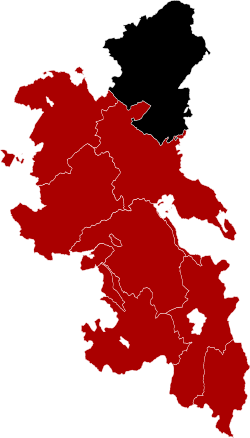Difference between revisions of "Newport Hundred"
| Line 4: | Line 4: | ||
==History== | ==History== | ||
| − | Until at least the time of the [[Domesday Survey]] in 1086 there were 18 hundreds in Buckinghamshire. It has been suggested however that neighbouring hundreds had already become more closely associated in the 11th century so that by the end of the 14th century the original or ancient hundreds had been consolidated into eight larger hundreds.<ref>[http://met.open.ac.uk/genuki/big/eng/BKM/hundreds/hhundreds.html Genuki - History of Buckinghaham Hundreds] Retrieved, May 21 2009</ref> Newport became the name of the hundred formed from the combined 11th-century hundreds of Bonestou, Moulsoe and Sigelai although these original names still persisted in official records until at least the early part of the 17th century. The court leet | + | Until at least the time of the [[Domesday Survey]] in 1086 there were 18 hundreds in Buckinghamshire. It has been suggested however that neighbouring hundreds had already become more closely associated in the 11th century so that by the end of the 14th century the original or ancient hundreds had been consolidated into eight larger hundreds.<ref>[http://met.open.ac.uk/genuki/big/eng/BKM/hundreds/hhundreds.html Genuki - History of Buckinghaham Hundreds] Retrieved, May 21 2009</ref> Newport became the name of the hundred formed from the combined 11th-century hundreds of Bonestou, Moulsoe and Sigelai although these original names still persisted in official records until at least the early part of the 17th century. The court leet was every three weeks near [[Gayhurst]] and in 1830 also took place at the Swan Inn, [[Newport Pagnell]].<ref name=VCH>[http://www.british-history.ac.uk/report.aspx?compid=62582 History on Line - Victoria County History - A History of the County of Buckingham - Newport Hundred: Volume 4, (1927), pp. 268-269.] Retrieved, May 22 2009</ref> |
Traces of the moot hill of Sigelai Hundred were discovered by archaeologists working for Milton Keynes Development Corporation, during the construction of [[Milton Keynes|Central Milton Keynes]]; the site is behind the central library and has been reconstructed.<ref>Source: Information board on the site.</ref> | Traces of the moot hill of Sigelai Hundred were discovered by archaeologists working for Milton Keynes Development Corporation, during the construction of [[Milton Keynes|Central Milton Keynes]]; the site is behind the central library and has been reconstructed.<ref>Source: Information board on the site.</ref> | ||
| Line 44: | Line 44: | ||
*[[Olney]] (with Warrington) | *[[Olney]] (with Warrington) | ||
*[[Ravenstone, Buckinghamshire|Ravenstone]] | *[[Ravenstone, Buckinghamshire|Ravenstone]] | ||
| − | *[[Shenley, Buckinghamshire|Shenley]] (Shenley Church End hamlet) | + | *[[Shenley, Buckinghamshire|Shenley]] (Shenley Church End hamlet)<sup>*</sup> |
*[[Sherington]] | *[[Sherington]] | ||
*[[Simpson, Buckinghamshire|Simpson]] | *[[Simpson, Buckinghamshire|Simpson]] | ||
| Line 59: | Line 59: | ||
*[[Woughton on the Green]] | *[[Woughton on the Green]] | ||
{{div col end}} | {{div col end}} | ||
| + | <sup>*</sup>: Shenley Brook End hamlet in Cottesloe Hundred. | ||
==References== | ==References== | ||
Revision as of 09:08, 5 February 2021
Newport Hundred is a hundred of Buckinghamshire. It is situated in the north of the county and adjoins Bedfordshire and Northamptonshire. It was commonly known as 'the three hundreds of Newport' because it amalgamated three earlier (11th-century) hundreds: Bonestou, Moulsoe and Siglelai (or Seckley).
History
Until at least the time of the Domesday Survey in 1086 there were 18 hundreds in Buckinghamshire. It has been suggested however that neighbouring hundreds had already become more closely associated in the 11th century so that by the end of the 14th century the original or ancient hundreds had been consolidated into eight larger hundreds.[1] Newport became the name of the hundred formed from the combined 11th-century hundreds of Bonestou, Moulsoe and Sigelai although these original names still persisted in official records until at least the early part of the 17th century. The court leet was every three weeks near Gayhurst and in 1830 also took place at the Swan Inn, Newport Pagnell.[2]
Traces of the moot hill of Sigelai Hundred were discovered by archaeologists working for Milton Keynes Development Corporation, during the construction of Central Milton Keynes; the site is behind the central library and has been reconstructed.[3]
Parishes and hamlets
Newport hundred comprises the following ancient parishes and hamlets:
- Astwood
- Bletchley
- Bow Brickhill
- Bradwell
- Bradwell Abbey
- Broughton
- Calverton
- Chicheley
- Clifton Reynes
- Cold Brayfield
- Emberton (with Petsoe Manor)
- Gayhurst
- Great Brickhill
- Great Linford
- Great Woolstone
- Hanslope (with Castlethorpe)
- Hardmead
- Haversham
- Lathbury
- Lavendon
- Little Brickhill
- Little Linford
- Little Woolstone
- Loughton
- Milton Keynes
- Moulsoe
- Newport Pagnell (with Caldecote)
- Newton Blossomville
- Newton Longville
- North Crawley
- Olney (with Warrington)
- Ravenstone
- Shenley (Shenley Church End hamlet)*
- Sherington
- Simpson
- Stantonbury
- Stoke Goldington
- Stoke Hammond
- Stony Stratford
- Tyringham (with Filgrave)
- Walton
- Wavendon
- Weston Underwood
- Willen
- Wolverton
- Woughton on the Green
*: Shenley Brook End hamlet in Cottesloe Hundred.
References
- ↑ Genuki - History of Buckinghaham Hundreds Retrieved, May 21 2009
- ↑ History on Line - Victoria County History - A History of the County of Buckingham - Newport Hundred: Volume 4, (1927), pp. 268-269. Retrieved, May 22 2009
- ↑ Source: Information board on the site.
| Hundreds of Buckinghamshire |
|---|
|
Ashendon • Aylesbury • Buckingham • Cottesloe • Newport • Chiltern Hundreds: Burnham • Desborough • Stoke |
